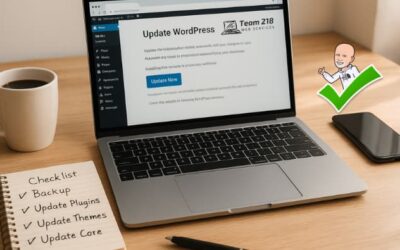Quick Summary (TL;DR)
Website management is the ongoing care and feeding of your site: updates, backups, security monitoring, fixes, and small content tweaks—plus reporting so you actually know what changed. If you’d rather not babysit plugins and hosting quirks, a managed plan is the sane choice.
See Website Management details · Get a free website audit
What “Website Management” Actually Covers
Core Maintenance
- Updates with a safety net: WordPress core, theme, and plugins—tested with staging/rollback when risk is high.
- 24/7 monitoring: Uptime checks, SSL/DNS sanity, fatal error alerts, resource spikes.
- Backups: Scheduled, offsite, and actually restorable (we test restores, not just toggle a checkbox).
- Security: Patching, firewall rules, malware scans, and fast remediation if something goes sideways.
Content & Minor Enhancements
- Publishing blog posts, swapping images, small copy edits, and tidy layout tweaks.
- Fixing broken links, light accessibility improvements, and routine housekeeping.
Reporting & Communication
- Monthly summary: What we updated, what we fixed, incidents handled, and what we recommend next.
Prefer a done-for-you plan? Jump to Website Management by Team 218.
Website Management vs. “Maintenance” (Not the Same Thing)
Maintenance is narrow: run updates and backups. Management is broader: proactive monitoring, fast fixes, content help, and ongoing guidance. The difference shows up in fewer emergencies, faster recovery, and fewer “why is the site down?” surprises.
Pricing Models (and What Affects Cost)
- Flat monthly “care plan”: Predictable, covers routine work and rapid responses.
- Hourly/T&M: Fine for rare changes, but costs swing when things break.
Cost drivers: plugin stack complexity, ecommerce, custom code, staging requirements, content cadence, and security posture. We quote based on your goals and risk profile—see how we think about it on our Website Pricing page.
DIY vs. Managed: A Practical Comparison
| Scenario | DIY | Managed |
|---|---|---|
| Simple brochure site, few plugins | Feasible if you’re comfortable and diligent. | Overkill unless you want zero mental overhead. |
| Ecommerce / bookings / memberships | Risky—plugin conflicts and downtime hurt revenue. | Safer—staging, rollbacks, and priority fixes. |
| Frequent content changes | Time sink, easy to skip best practices. | Faster throughput, consistent standards. |
| Compliance / board reporting | Manual logs (if you remember). | Monthly reports and verifiable change history. |
Checklist — What a Good Plan Should Include
- ✅ Backups you can actually restore (schedule + periodic restore test)
- ✅ Update policy (staging & rollback for risky updates)
- ✅ Uptime & security monitoring with alerting
- ✅ Monthly report of changes, incidents, and recommendations
- ✅ Critical-fix response time defined in writing (SLA)
- ✅ Access & license ownership is clear (no hostage nonsense)
See plan details · Request a free audit · Contact Team 218
How to Choose a Provider (10 Smart Questions)
- Do you test updates on a staging site before pushing live?
- What’s your rollback process when an update breaks something?
- How do you handle plugin conflicts or abandoned plugins?
- What exactly is included each month, and what’s billable?
- What’s your security patching policy and toolset?
- How do you document and report your work?
- What is the emergency response time and communication channel?
- Who owns my accounts, licenses, and data?
- Do you support accessibility improvements?
- What happens if we part ways—how do you hand off cleanly?
Realistic Outcomes (No Magic Beans)
- Fewer outages and faster fixes when issues pop up.
- Cleaner Core Web Vitals baseline and fewer surprise regressions.
- Executive/board-friendly reporting for accountability.
- Still not a ranking guarantee—pair with ongoing SEO for growth.
FAQs
Is “website management” the same as maintenance?
No—maintenance is a subset (updates/backups). Management adds monitoring, fixes, content help, and reporting.
How often should plugins and themes be updated?
Weekly for routine updates; security patches ASAP. Use staging and keep rollback handy for big changes.
Do I need a staging site?
If you run ecommerce, rely on heavy plugins, or have custom code—yes. Staging reduces breakage risk.
What does 24/7 monitoring actually catch?
Uptime drops, SSL expiration, DNS/host hiccups, fatal errors, and resource spikes that can knock a site offline.
What’s a fair monthly price for a small WordPress site?
It depends on complexity and risk. We scope and quote transparently—see Website Pricing.
Next Steps
See our Website Management details (primary) · Get a free website audit · Talk to a human
Last updated: August 17, 2025








0 Comments